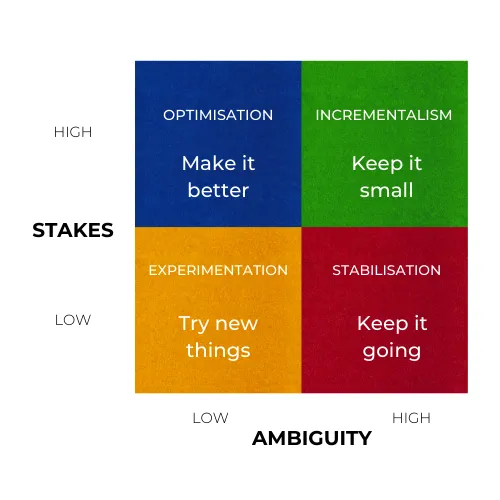New stuff is fun. It's my favourite. I like nothing more than throwing everything I've done, worked for, or worked on, away and starting with a blank sheet. Fresh exercise book. New pen. Rearranged lounge.
Except once you're a grown-up, you never really get a blank sheet, do you? There's too many loose ends.
So, how do we ever get to make something big and new happen, when we have to keep things running in the meantime?
We can, but we need to use our energy wisely, otherwise we'll try and change everything at once, burn out, and die. Or something like that.
Whether you're working out whether to overhaul your tech stack (my current battle), find a new job or relationship, launch a change program or renovate yourself, big change decisions are really hard.
If you're trying to work out whether to start all over again, or just tweak around the edges, whether to throw it all out, or experiment with something different, here's a helpful way to think about it.
Most decisions that matter are complicated, but you can usually work out their significance and risk by focusing on two main factors:
- How ambiguous the situation is
- How high the stakes are.
Ambiguity
How much do you know about this decision? How many of the factors are uncertain? Have you done this before? How many people are involved?
Stakes
How much is resting on this? What will the impact be if it goes wrong? How much do you depend on this going well? What is at stake?
The Change Matrix

Using the tool
Once you've worked out, approximately, you sit on the matrix, use the prescription to guide how you go about tackling your change project.
When to experiment
When there's low ambiguity and low stakes, we should try new things while it's safe. This is great for hobbies, outfits and activities! Why not?
When to optimise
When there's low ambiguity, but high stakes, we should look for the best solution, rather tham innovating. Here, we should do what's smartest for our wallet, time and big goals. This is usually true for large purchases, career and relationship choices.
When to stabilise
When ambiguity is high, but decision stakes are low, we should keep things on an even keel. There's enough going on. If you're mid restructure and wondering whether to switch gyms or get a dog - don't. Wait. It doesn't matter right now.
When to incrementalise
When ambiguity is high, and the stakes are high, we should make decisions as small as possible, so we can shift as things change. So, if you're mid restructure and wondering whether to end your marriage... don't blow it up - but don't just let it sit, either. Small steps. Tiny choices. You'll find your way.
Facing a tough choice? Give this a go and see if it's useful for you.










